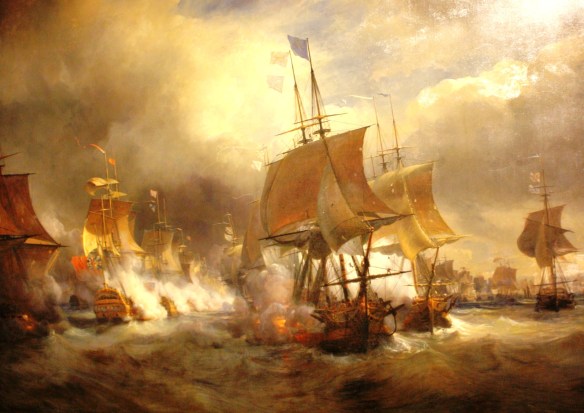Depiction of the battle by Théodore Gudin, c. 1848.
For Great Britain, the arrival of d’Estaing’s Toulon squadron in American waters not only marked the transition from a mostly local struggle to suppress a colonial rebellion into a wider and ultimately global conflict, but also presaged the strategic and operational difficulties under which Royal Navy commanders would labor until the peace of 1783. The French navy, whatever its shortcomings, was at its best during the 1778–1783 war; Great Britain’s Royal Navy was beset by troubles, and not solely those related to its tactics. Quite simply, there were not enough ships to meet all the demands placed on the Royal Navy. At the strategic level, as Piers Mackesy concluded in his study of the American war, “the British fleet was never strong enough to impose a sustained blockade” as had Hawke, for example, during the Seven Years’ War. Operationally, the French were able to send powerful fleets and squadrons, such as d’Estaing’s, to North American, Caribbean, and Indian Ocean waters. As a result, at the tactical level Royal Navy commanders rarely possessed more than numerical parity with their French, and later Spanish, foes.
Thus when the French entered the war in the spring of 1778 they held the strategic initiative. Nevertheless, they were not prepared to launch an invasion of Great Britain at that time. French planners had developed myriad schemes to invade the British Isles, but considered such a move premature until Spain entered the war with its large fleet.
When the conflict began, the British were uncertain about French intentions, especially the destination of d’Estaing’s Toulon squadron. The prime minister, Frederick Lord North, and John Lord Sandwich, first lord of the admiralty, did not expect an immediate invasion, but Vice Admiral Augustus Keppel, commander of the Channel fleet, did expect one and insisted on the reinforcement of his command. Since the Royal Navy’s senior leaders, including Sandwich, Howe, and Keppel, believed their service lacked sufficient force to establish a close blockade, their short-term options were limited: reinforce the Channel fleet or send a squadron to Gibraltar to prevent d’Estaing from leaving the Mediterranean. The ministry’s political weakness led North and Sandwich to choose the safest course—reinforcing Keppel.
The French foreign minister, the comte de Vergennes, was not an advocate of an all-out invasion and had no intention of launching an assault with even limited goals until Spain added the weight of its fleet to the scales already tipped against Britain. In the interim, Vergennes adopted a plan drawn up by the navy. The main fleet from Brest would demonstrate in the vicinity of the Channel, not to seek battle but to hold the attention of the Royal Navy in Europe, while the Toulon squadron quit the Mediterranean and crossed the Atlantic, giving France at least temporary naval superiority in American waters.
In the summer, Vice Admiral Louis Guillouet, comte d’Orvilliers, sailed from Brest with thirty-two of the line under orders to avoid battle but to remain at large for at least thirty days. D’Orvilliers doubted that he could do both, but sailed nonetheless. Keppel’s Channel fleet, now reinforced and thirty ships of the line strong, sailed in pursuit. The French, holding the wind advantage, avoided battle for several days but, as d’Orvilliers had foreseen, an inevitable shift of the wind finally brought the two fleets into contact on 27 July 1778 off the island of Ushant, about thirty miles west and somewhat north of Brest. The resultant battle was a confused, inconclusive, daylong encounter. The French suffered higher casualties among their crews; British ships suffered greater material damage, especially to their rigging. In the afternoon, when both commanders had opportunities to concentrate force against a portion of their opponent’s fleet, first Keppel, then d’Orvilliers, and then Keppel again lost control of their forces and failed to bring on a “decisive” engagement. In London, as after the battles of Toulon and Minorca, there were recriminations: charges and countercharges followed by a pair of courts-martial— one of Keppel, the other of his recalcitrant subordinate Vice Admiral Sir Hugh Palliser.
One can attribute the lack of results at Ushant to the two navies’ adherence to the “stultifying” line ahead, but the important lessons of the battle have little to do with linear formations. Like the battles at Toulon and Minorca, Ushant was the first major naval battle of the war. As Captain John Jervis wrote soon after Ushant: “Two fleets of equal force can never produce decisive events, unless they are equally determined to fight it out, or the commander-in-chief of one of them bitches it so as to misconduct his line.” The main problem that plagued both Keppel and d’Orvilliers was not their adherence to the line but the failure of their command systems. At critical junctures during the battle, the system of control—relying on visual signals and messages passed to subordinates in frigates—proved woefully unresponsive. Haze and smoke often blocked the views of the commanders in chief. Their signals often were ignored, went unseen, or were misinterpreted.
